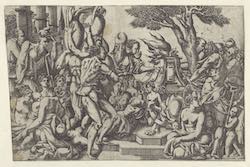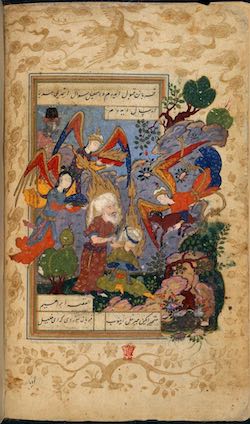Topic: 2. Sacrifice and religion: Comparisons, Antiquarians, Anthropology (16th-18th Century)
Religious sacrifices across various cultures and contexts sparked widespread interest in Early Modern Europe. As Christianity expanded into regions inhabited by "infidels" and "pagans", Europeans encountered a diverse array of sacrificial customs, ranging from the Sati rituals in India to the Aztec sacrifices in the Americas. This cross-cultural exposure captivated a wide audience, including theologians, philosophers, political thinkers, antiquarians, orientalists, missionaries, poets, artists, and even the general public. These encounters broadened the European understanding of sacrifice and led to a critical reassessment of classical and biblical sacrificial rites. This section includes:
- Sources: A selection of early modern printed materials, which include descriptions of the Americas, Asia, and Africa, alongside antiquarian and philological studies on religious sacrifice in classical antiquity and beyond. It also presents early modern works of ethnological observations and the first attempts to compare different sacrificial practices in various traditions and contexts, laying the groundwork for disciplines like the history of religions and anthropology.
- Iconographic Representations: A rich collection of images from the 16th to 18th centuries, illustrating a range of sacrificial rituals and practices as seen in different cultural and geographical contexts.
- Related Bibliography: An extensive bibliography spanning scholarly works from the 19th to 21st centuries, providing contemporary analyses and interpretations of these early studies and observations.
Some Features and Forms of Nuer Sacrifice
in: Africa, v. 21 (1951), issue : pp.112-121.
The Sacrificial Role of Cattle among the Nuer
in: Africa, v. 23 (1953), issue : pp.181-198.
The Meaning of Sacrifice among the Nuer
in: Journal of the Royal Anthropological Institute, v. 84 (1954), issue : pp.21-33.
Le sacrifice de Noé: situation, interprétations
in: Sacrificio: questioni, interpretazioni, comparazioni [Storicamente, special issue], v. 18 (2022), issue 44: pp.https://storicamente.org/fabre_sacrifice_noe.
Ad tit. cod. Theodosiani de paganis, sacrificiis, & templis, notae
Lutetia: Sebastianus Cramoisiy, 1618.
L’ostilità antiebraica nel mondo cattolico: un percorso storiografico e politico
in: Annali di storia dell'esegesi, v. 37 (2020), issue 1: pp.225-264.
Infamanti dicerie. La prima autodifesa ebraica dall’accusa del sangue
Bologna: Edizioni Dehoniane, 2014.
Seeing Religion: Religious Diversity and Urbanity
in: Religion and Urbanity Database, pp. Open access
Berlin: De Gruyter, 2022.
Consecration of Animals
in: Encyclopaedia of the Qurʾān, pp. 401-404ONLINEhttps://referenceworks.brillonline.com/entries/encyclopaedia-of-the-quran/consecration-of-animals-EQCOM_00040
Brill: Leiden, 2001.
Pagan sacrifice (17th)
from: Catalogo generale dei Beni Culturali
Pinacoteca Nazionale di Bologna, Gabinetto dei Disegni e delle Stampe
Sacrificial scene inspired by a work of Rosso Fiorentino (1542)
Rijksmuseum, Amsterdam
Greek and Roman Animal Sacrifice: Ancient Victims, Modern Observers
Cambridge: Cambridge University Press, 2012.
“Searching for the New”: Later Safavid Painting and the “Suz u Gawdaz” (“Burning and Melting”) by Nau’i Khabushani
in: The Journal of the Walters Art Museum, v. 59 (2001), issue : pp.115–130.
Il sacrificio biblico: uno sguardo antropologico
in: Materia Giudaica, v. 24 (2019), issue : pp.535-545.
1. Sacrifice and Bible (16th-18th Century) 2. Sacrifice and religion: Comparisons, Antiquarians, Anthropology (16th-18th Century)
Ibrahim about to sacrifice Ismail. Cebrail (Gabriel) stands nearby holding the ram. (Late 16th/Early 17th)
from: A miniature painting from a manuscript of Hadikat us-suada, a history of the holy martyrs of the Prophet's family [Ms Or. 12009, fol.19v]
British Library, London [from Turkey]
The Lord's Table : Eucharist and Passover in early Christianity
Philadelphia: University of Pennsylvania Press, 1981.
Brigands and Cruel Kings
in: The Oxford Handbook of Heracles, pp.
Oxford: Oxford University Press, 2021.



